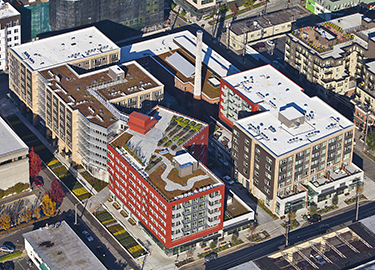|
Subscribe / Renew |
|
|
Contact Us |
|
| ► Subscribe to our Free Weekly Newsletter | |
| home | Welcome, sign in or click here to subscribe. | login |
Architecture & Engineering
| |
 |
October 31, 2013
A&E 2013 Surveys: Runberg Architecture Group
Specialty: Urban housing, adaptive reuse
Management: Brian Runberg, Michele Wang, partners; Melissa Wechsler, Larry Flack, Constanza Marcheselli, principals
Founded: 1998
Headquarters: Seattle
2013 revenues: $4 million
Projected 2014 revenues: $4 million
Projects: Stack House apartments; Ballard Tallman; 9th and Pine; 8th and Republican
Runberg Architecture Group has played a big role in the surge of apartments being built in South Lake Union. The company emphasizes creating designs that fit in with neighborhoods and use unique elements such as setbacks from the street and open space. Brian Runberg spoke with the DJC about the apartment boom in Seattle and some of the important design trends:
Q: What is driving the apartment boom here, and will it slow down?
A: It’s largely been driven by a perfect storm left in the wake of the recession. The building industry virtually came to a standstill for three years; home-ownership trends went in reverse and have yet to fully return. Fortunately for us here in the Northwest, job growth within the urban center has come back incredibly strong. The combination of reduced home ownership and job growth is a recipe for increased demand in urban housing.
Naturally this boom cannot sustain the current frenzied pace. The return of home ownership may affect the pace of new development more quickly than the construction of more apartments.
Q: What neighborhoods besides the obvious are popular among developers?
A: We see areas like Pioneer Square, Sodo, Yesler Terrace, Central District and Beacon Hill (as) areas with untested growth opportunities. Given growth projections for the region, pushing for appropriate density in urban centers and along frequent transit corridors is a logical focus.
We are not seeing many neighborhoods completely overlooked; rather, we are reassessing and studying some unique and challenging urban sites in different ways.
Q: With so many new units being built, how can developers stand out?
A: There is obvious room for improvement in the housing industry — in operational function, appearance, and even in how they are built. Breaking away from business as usual or changing the status quo can be out of the comfort range for many developers and equity investors. However, if we’ve learned anything in this post-recession era it is that the same old paradigm doesn’t necessarily work.
Many old rules are changing as projects are being designed or before they’re built. Recycling a formula that worked last time is building in obsolescence before ever starting and results in diminished market value and return.
We understand the need to reduce risk for clients and provide return on their investment, yet, as an industry, we have a responsibility to constantly improve the product. It is starting to prove out in the industry as recent CoStar studies identify that Energy Star and LEED certification can add 10 to 15 percent in market valuation.
Given that these buildings are going to be around for several decades, there is a societal responsibility for us to collectively push these boundaries and have a broader positive impact.
Q: What are the big trends in urban apartment design?
A: First and foremost, strive for performance-based results rather than chase the latest trend. Optimizing building performance is imperative in the new economy. Specifically, we are pressing on integrating sustainable building practices that can lead to savings for the owner and the tenants alike. Some are high-tech, however some are low-tech, commonsense approaches.
Innovation in building technology will continue in the future in terms of smart energy systems, enhanced heat recovery, energy monitoring, water conservation, mechanical/electrical systems, building materials, and even advanced construction techniques. Margins are always tight in this product type, but there are opportunities to implement these strategies economically.
When factoring life-cycle costs, many of these measures are proving to be both economically prudent and environmentally appropriate. We’ve been thankful to work with some at the forefront of environmental innovation, such as Vulcan Real Estate, and others who have been receptive to this forward-thinking approach.
Other Stories:
- ‘Standard of care’ is all about reasonable expectations
- A&E 2013 Surveys: BergerABAM
- A&E 2013 Surveys: PAE Consulting Engineers
- A&E 2013 Surveys: Freiheit & Ho Architects
- A&E 2013 Surveys: Fossatti Pawlak Structural Engineers
- A&E 2013 Surveys: Hewitt
- A&E 2013 Surveys: GGLO
- Architecture: It’s not science, it’s art
- Designing a waterfront entrance for Pike Place Market
- Now hear this: ADA updates listening device rules
- Tech influence ripples across the design world
- Can’t find a lender? Try crowdfunding
- A&E 2013 Surveys: Weber Thompson



